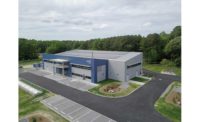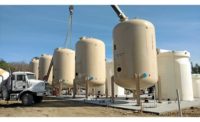Virginia Water Plant To Be a Multipurpose Unit

Workers prepare the footprint of the SWIFT Research Center with reinforcing steel as they prepare to place concrete.
PHOTO COURTESY OF HAMPTON ROADS SANITATION DISTRICT

Two buried pump stations, including one that will provide water to the Granular Activated Carbon vessels.
PHOTO COURTESY OF HAMPTON ROADS SANITATION DISTRICT

Schematic diagram depicts multiphase treatment process that renders wastewater suitable for return to the aquifer.
RENDERING COURTESY OF HRSD



A $25-million demonstration project under construction in Suffolk, Va., will show officials from the Hampton Roads Sanitation District how to address a myriad of problems facing the water utility, including a rapidly shrinking water aquifer, land subsidence and a potential checklist of requirements for restoration of the Chesapeake Bay.
The project, funded almost entirely by ratepayers, is part of HRSD’s Sustainable Water Initiative for Tomorrow (SWIFT) program, which ultimately could result in $1 billion in projects at seven of HRSD’s nine wastewater treatment plants and provide up to $2 billion in credits for other local utilities under the Total Maximum Daily Load (TMDL) program for the Chesapeake Bay.
HRSD’s SWIFT program is a managed aquifer recharge program that will purify HRSD’s wastewater to drinking-water quality and pump it back into the Potomac aquifer. Although similar projects have been built in other parts of the country, most notably the Groundwater Replenishment System in Orange County, Calif., SWIFT is a first of its kind on the East Coast, says HRSD’s director of engineering, Bruce Husselbee.
According to HRSD’s general manager Ted Henifin, the idea for SWIFT grew out of a need to address multiple problems.
Local water managers, environmental groups and the U.S. Geological Service have worried for years about falling water levels and land subsidence in and around the Potomac aquifer, which is the primary source of groundwater in eastern Virginia and a significant component of the Atlantic Coastal Plain system running from Georgia to New Jersey.
Since the early 1900s, water levels in the Potomac aquifer have fallen by more than 200 feet, and those levels continue to drop each year. As the water levels fall, so does the pressure in the geologically deep confined aquifer, which causes sediments underneath to compact, and the land around the aquifer to sink.
But land subsidence was not Henifin’s top concern when he and other senior utility leaders began planning for the future. Knowing that Chesapeake Bay and other water quality requirements would most likely become more stringent, they decided any water would be too valuable to waste. “The lightbulb just went on: We’re going to have drinking-level quality water, and we’ve got groundwater issues in the region. Let’s put these two things together,” Henifin says.
The 27,750-sq-ft demonstration advanced treatment research facility at HRSD’s Nansemond plant in Suffolk, Va., broke ground in March and is expected to be substantially complete by January 2018. In early June, construction crews began pouring concrete for the walls in the pump station and the walls in the deep-process trench, installing under-slab piping, conduits and reinforcement for the larger building slabs.
If all goes well, HRSD hopes to begin the full-scale, $1-billion program in 2019, Husselbee says.
The facility is being built by a design-build team of Charlotte, N.C.-based Crowder Construction Co. and New York City-based Hazen and Sawyer, with CH2M as a consultant. “Our goal is to have one year of the demonstration running before we start designing the full-scale [projects],” Husselbee says. Dan Holloway, a principal project manager and professional geologist at CH2M, says the ability to pump up the clay-based sediments laying above the sandy soil in the aquifer once they are compacted “is limited, so it’s very important to do something about this now.”
HRSD Project Manager Lauren Zuravnsky notes the research facility will demonstrate how much the treatment processes can be optimized, or “pushed” beyond the current design capacity. The information collected during different loading rates will enable HRSD to improve the efficiency of both design and operation of the full-scale facilities. This in turn should translate into capital and operational cost savings, she says.
Once the demonstration phase is complete, project leaders will begin preparing for similar advanced treatment facilities at seven of the nine plants it operates. Those projects will most likely begin in 2019, and be built over the next 11 years, Husselbee says, for a total cost of nearly $1 billion.
Cleaner Than Clean
The demonstration project currently being built follows a project completed at HRSD’s York plant in August 2016. That pilot project compared two different forms of treatment side by side: granular activated carbon and reverse osmosis.
GAC proved to be more cost-effective, Husselbee says, and that is what is being incorporated into the larger, 1-million-gallon-a-day demonstration project.
After initial treatment, chemicals will be added to match the treated water to the geochemistry of the water in the aquifer. Water will then be pumped to a recharge well through a pump column pipe with enough pressure to permeate through the surrounding sand layers of the aquifer.
The SWIFT water will displace native groundwater already present between the grains of sand in the aquifer adjacent to the well. The highly treated water will slowly move in a radial direction outward from the well, pressurizing the aquifer system, according to Zuravnsky.
Because HRSD will exceed its own requirements for nitrogen, phosphorus and sediment under the Chesapeake Bay TMDL through the SWIFT program, other utilities in the region will be able to obtain credits to avoid building similar nutrient-reduction projects.
The independent, nonpartisan National Water Research Institute, based in Orange County, Calif., has established a panel to evaluate and ultimately make recommendations to HRSD about the project. It is a significant project because of its size and scale, as well as the fact that it addresses multiple challenges, says Kevin Hardy, NWRI executive director.
With SWIFT, “We know the technology works. … Every community has unique physical properties and economic concerns,” Hardy says. “In some cases, HRSD is such a large and diverse district that there may be some adaptations to the strategy from site to site, because we’re talking about a place where there will be multiple injection wells to pump advanced treated water into the basin,” he says.
The panel, chaired by Glen Daigger, formerly with CH2M and now a University of Michigan faculty member, has met twice already to study the project, and plans to meet some time in the next quarter before issuing any recommendations.








